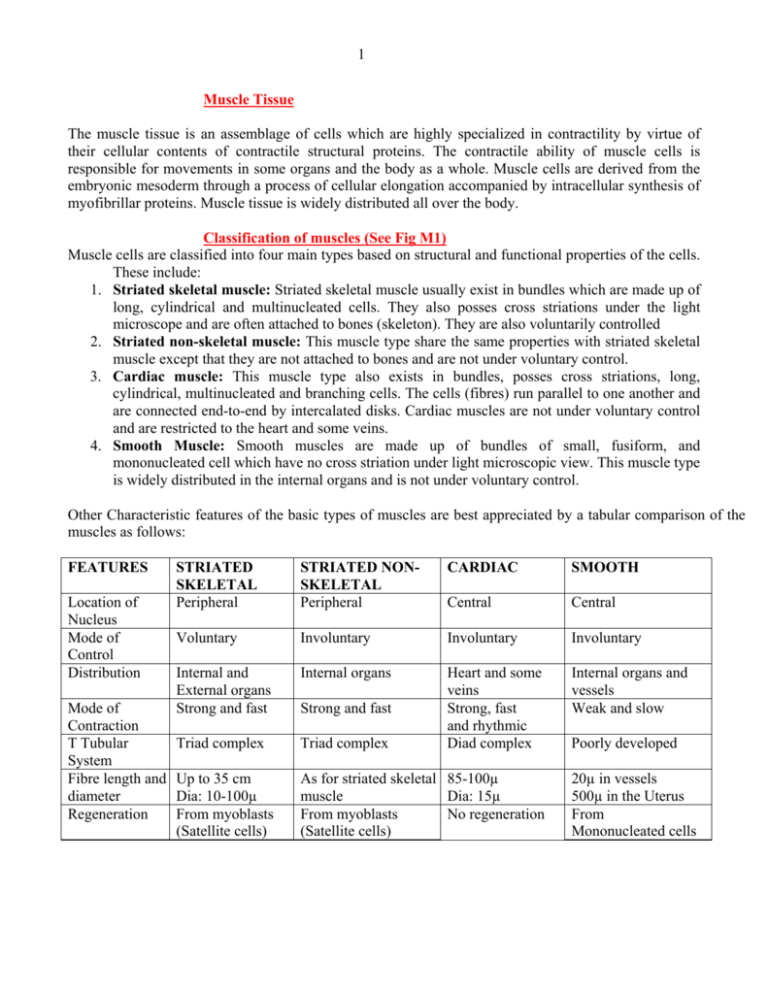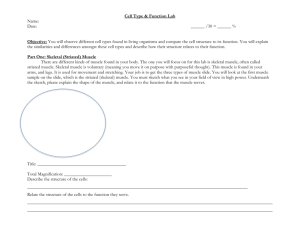1 Muscle Tissue The muscle tissue is an assemblage of cells which
advertisement

1 Muscle Tissue The muscle tissue is an assemblage of cells which are highly specialized in contractility by virtue of their cellular contents of contractile structural proteins. The contractile ability of muscle cells is responsible for movements in some organs and the body as a whole. Muscle cells are derived from the embryonic mesoderm through a process of cellular elongation accompanied by intracellular synthesis of myofibrillar proteins. Muscle tissue is widely distributed all over the body. Classification of muscles (See Fig M1) Muscle cells are classified into four main types based on structural and functional properties of the cells. These include: 1. Striated skeletal muscle: Striated skeletal muscle usually exist in bundles which are made up of long, cylindrical and multinucleated cells. They also posses cross striations under the light microscope and are often attached to bones (skeleton). They are also voluntarily controlled 2. Striated non-skeletal muscle: This muscle type share the same properties with striated skeletal muscle except that they are not attached to bones and are not under voluntary control. 3. Cardiac muscle: This muscle type also exists in bundles, posses cross striations, long, cylindrical, multinucleated and branching cells. The cells (fibres) run parallel to one another and are connected end-to-end by intercalated disks. Cardiac muscles are not under voluntary control and are restricted to the heart and some veins. 4. Smooth Muscle: Smooth muscles are made up of bundles of small, fusiform, and mononucleated cell which have no cross striation under light microscopic view. This muscle type is widely distributed in the internal organs and is not under voluntary control. Other Characteristic features of the basic types of muscles are best appreciated by a tabular comparison of the muscles as follows: FEATURES Location of Nucleus Mode of Control Distribution Mode of Contraction T Tubular System Fibre length and diameter Regeneration STRIATED SKELETAL Peripheral STRIATED NONSKELETAL Peripheral CARDIAC SMOOTH Central Central Voluntary Involuntary Involuntary Involuntary Internal and External organs Strong and fast Internal organs Internal organs and vessels Weak and slow Triad complex Triad complex Heart and some veins Strong, fast and rhythmic Diad complex Up to 35 cm Dia: 10-100µ From myoblasts (Satellite cells) As for striated skeletal 85-100µ muscle Dia: 15µ From myoblasts No regeneration (Satellite cells) Strong and fast Poorly developed 20µ in vessels 500µ in the Uterus From Mononucleated cells 2 Histological Organization of Muscles (See Fig M2) For all muscle type, the cell membrane is referred to as the sarcolemma, the cytoplasm is called the sracoplasm and the endoplasmic reticulum is called the sarcoplasmic reticulum. An entire muscle is often surrounded by a connective tissue sheath called Epimysium. Each bundle of muscle cells within the epimysium is enclosed in a connective tissue sheath called Perimysium. Each muscle cell is surrounded by a connective tissue sheath called Endomysium. The connective tissue sheaths surrounding the muscle cells contain capillary network, nerve plexus and lymphatic vessels. 3 Internal Organization of the Skeletal Muscle (See Fig M3A & M3B): A skeletal muscle fibre may be up to 35 cm in length with a diameter ranging from 10 to 100 micron Under the light microscope, a longitudinal section of a skeletal muscle fibre show cross-striation which comprises alternating dark and light bands The dark bands are referred to as the A band (Anisotropic band) and the Light band as the I band (Isotropic band). Under electron microscopic view, each I band is divided in the middle by a transverse line called the Z line. The dark bands are also formed by Myosin contractile proteins while the light bands are formed by Actin contractile proteins. The contractile apparatus of the muscle is subdivided into subunit referred to as the Sarcomere. The distance from one Z line to the next one constitutes the Sarcomere of the skeletal muscle (See Diagram). Sarcomeres are also interconnected at the Z line by the proteins α-actinin and desmin. Under the electron microscope, the A band is also divided in the middle by a transverse line called the M Line. This is the region at which adjacent myosin are interconnected laterally. It is also formed mainly by creatine kinase a protein involved in the synthesis of ATP. There are two light zones on either side of the M line. These collectively constitute the H band within the A band. In this region there is no overlap between myosin and actin (See Fig. M3). 4 5 6 Contractile Proteins of the Striated muscle (See Fig. M4): Myosin and actin are the principal protein of the myofibrils constituting 55% of myofibrillar proteins. While myosin form the thick filaments, actin forms the thin filament. Two other contractile proteins associated with the thin filaments are: • Tropomyosin and • Troponin 7 The Tubular systems of the Skeletal Muscle (See Fig. M5A & M5B): The tubular systems of the striated muscle comprise the: The transverse (T) tubules: These are finger-like invaginations of the sarcolemma which form tubular network around the myofibril at the junction the light and dark bands. They serve as channels through which electrical impulse is propagated from the surface to the interior of the muscle cell. Sarcoplasmic Reticulum tubules: The smooth sarcoplasmic reticulum of the muscle cell form terminal cisternae on either side of the T tubular network leading to the establishment of a system of three tubules referred to as the Triad complex of tubules. The sarcoplasmic tubules contain calcium ions which are released from the tubules on stimulation by the impulse passing along the T tubular network (See Diagram). 8 9 10 Other Contents of the sracoplasm of skeletal muscle: Glycogen: This is the energy source of the muscle and is stored in granules. Myoglobin: This is an oxygen binding protein similar to hemoglobin in blood. It imparts dark red color on the muscle Internal Organization of the Cardiac Muscle (See Fig. M6A & M6B): Cardiac muscle has an average diameter of 15µ and length range of 85-100µ. Most cells are mononucleated but a few are binucleated. In all cases the nuclei are centrally located. Cardiac muscle consists of branching muscle fibres and adjacent fibres are connected end-end via these branches by intercalated disks. Intercalated disks are specialized junctional complexes which are peculiar to cardiac muscle. They are made up of three components viz. • Fasciae Adherentes which serve as anchoring site for actin fibres • Maculae Adherentes which bind cardiac muscle fibres together and • Gap Junctions which provide channels for ionic and electric flow between cardiac muscle cells (fibres). The arrangement of myofibrils in the cardiac muscle is similar to the arrangement in skeletal muscle. Cardiac Tubular System: The T-tubular systems are larger and more numerous compared with skeletal muscle. However, only one sarcoplasmic reticular tubule is associated with the T-tubule thus a diads tubular system is established in the cardiac muscular system. Other features of the sracoplasm of cardiac muscle include: • Abundance of mitochondria which constitute 40% of the sracoplasm • Large deposit of fatty acids as glyceride as the major fuel of cardiac muscle • Small amount of glycogen • Granules of lipofuscin pigments • Granules of the precursor of Atrial natriuretic factor which is stored in large amount (around the nucleus) in the right atrium and less quantity in other cardiac muscles. 11 12 Internal Organization of the Smooth Muscle (Fig. M7A & 7B) The length of the spindle shaped smooth muscle cell varies from one organ to the other. In the vascular wall it is about 20µ while in the gravid uterus it could be as long as 500µ. Smooth muscle cell is surrounded by a basal lamina and a network of reticular fibres which ensures that a bundle of smooth muscle contract in unison. Smooth muscle lacks T-tubular system but widely distributed sarcoplasmic reticulum. The myofibrils which comprise myosin actin and tropomyosin are arranged in a crisscross pattern. The contractile filaments are attached to focal densities in the sracoplasm and to attachment densities on the sarcolemma. The mechanism of contraction of actin and myosin filament is similar to the mechanism in skeletal muscle. Intermediate filaments called desmin are also found in the smooth muscle. Electrical and ionic communication between smooth muscle cells are effected through Nexus (Gap) junctions. Other sarcoplasmic contents of the smooth muscle include: • Calmodulin: This is a calcium binding protein which forms a complex with calcium ions. The complex so formed activates the interaction between myosin and actin. • Mitochondria • Polyribosomes • Rough endoplasmic reticulum • Golgi complex • Pinocytotic vesicles Regeneration of muscle tissue: Striated skeletal and non-skeletal muscles increase in size and number by proliferation of inactive myoblasts called satellite cells. Smooth muscles also regenerate from mononucleated cells. Cardiac muscles are incapable of regeneration. The Neuromuscular Junction (See Fig. M8): This is the contact point between the muscle and its nerve supply. It is also referred to as the Myoneuronal junction or Motor end plate: The principal features of this structure are: 1. Demyelination of the synaptic bulb 2. Synaptic Cleft (gap) containing neurotransmitter 3. Synaptic junctional folds on the sarcolemma 4. Presynaptic vesicles containing neurotransmitter 5. Pre and Post synaptic abundance of Mitochondria 6. Several nuclei ribosomes and glycogen granule beneath the junctional folds 7. Neurotransmitter receptors on the sarcolemma 13 14 15






